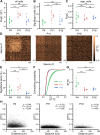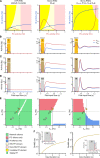Network instability dynamics drive a transient bursting period in the developing hippocampus in vivo
- PMID: 36534089
- PMCID: PMC9762703
- DOI: 10.7554/eLife.82756
Network instability dynamics drive a transient bursting period in the developing hippocampus in vivo
Abstract
Spontaneous correlated activity is a universal hallmark of immature neural circuits. However, the cellular dynamics and intrinsic mechanisms underlying network burstiness in the intact developing brain are largely unknown. Here, we use two-photon Ca2+ imaging to comprehensively map the developmental trajectories of spontaneous network activity in the hippocampal area CA1 of mice in vivo. We unexpectedly find that network burstiness peaks after the developmental emergence of effective synaptic inhibition in the second postnatal week. We demonstrate that the enhanced network burstiness reflects an increased functional coupling of individual neurons to local population activity. However, pairwise neuronal correlations are low, and network bursts (NBs) recruit CA1 pyramidal cells in a virtually random manner. Using a dynamic systems modeling approach, we reconcile these experimental findings and identify network bi-stability as a potential regime underlying network burstiness at this age. Our analyses reveal an important role of synaptic input characteristics and network instability dynamics for NB generation. Collectively, our data suggest a mechanism, whereby developing CA1 performs extensive input-discrimination learning prior to the onset of environmental exploration.
Keywords: development; in vivo; mouse; network modeling; neuroscience; two-photon Ca2+ imaging.
© 2022, Graf, Rahmati et al.
Conflict of interest statement
JG, VR, MM, OW, CG, SK, KH, KK No competing interests declared
Figures














Similar articles
-
Heterogeneous populations of cells mediate spontaneous synchronous bursting in the developing hippocampus through a frequency-dependent mechanism.Neuroscience. 2000;97(2):227-41. doi: 10.1016/s0306-4522(00)00029-4. Neuroscience. 2000. PMID: 10799755
-
Enhanced burst discharges in the CA1 area of the immature versus adult hippocampus: patterns and cellular mechanisms.J Neurophysiol. 2022 Dec 1;128(6):1566-1577. doi: 10.1152/jn.00327.2022. Epub 2022 Nov 16. J Neurophysiol. 2022. PMID: 36382903 Free PMC article.
-
The Dendrites of CA2 and CA1 Pyramidal Neurons Differentially Regulate Information Flow in the Cortico-Hippocampal Circuit.J Neurosci. 2017 Mar 22;37(12):3276-3293. doi: 10.1523/JNEUROSCI.2219-16.2017. Epub 2017 Feb 17. J Neurosci. 2017. PMID: 28213444 Free PMC article.
-
CA2 orchestrates hippocampal network dynamics.Hippocampus. 2023 Mar;33(3):241-251. doi: 10.1002/hipo.23495. Epub 2022 Dec 27. Hippocampus. 2023. PMID: 36575880 Free PMC article. Review.
-
[Neural mechanism underlying generation of synchronous oscillations in hippocampal network].Brain Nerve. 2008 Jul;60(7):755-62. Brain Nerve. 2008. PMID: 18646615 Review. Japanese.
Cited by
-
Chemogenetic silencing reveals presynaptic Gi/o protein-mediated inhibition of developing hippocampal synchrony in vivo.iScience. 2024 Sep 20;27(10):110997. doi: 10.1016/j.isci.2024.110997. eCollection 2024 Oct 18. iScience. 2024. PMID: 39429781 Free PMC article.
-
Multiphoton imaging of hippocampal neural circuits: techniques and biological insights into region-, cell-type-, and pathway-specific functions.Neurophotonics. 2024 Jul;11(3):033406. doi: 10.1117/1.NPh.11.3.033406. Epub 2024 Mar 8. Neurophotonics. 2024. PMID: 38464393 Free PMC article. Review.
References
Publication types
MeSH terms
LinkOut - more resources
Full Text Sources
Molecular Biology Databases
Research Materials
Miscellaneous

